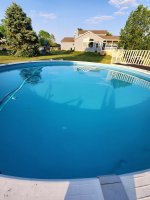13k above ground, pH 7.5, FC 10.0, CYA 60
Apparently I have too much time on my hands this year because I have decided to wage the ever-ending war against my insanely High total alkalinity. It's sitting somewhere between 220 and 250. I use the TF 100 test kit like everybody else and it's amazing. I just don't know, when it says turn red, is it talking about when it just starts to turn a little pink.. a little bit more pink.. magenta.. fire engine red? That's not my main question that's a sidebar.
The pool math app does not tell you how much muriatic acid to add when you click on the results from your total alkalinity test. It just says use acid to bring it down and aerate to bring the pH back up. A general Google search tells me that in a 10,000 gallon pool I need approximately 25.6 oz of MA to lower my total alkalinity 10 parts per million. With trying to get my total alkalinity down to 90 that is a staggering 11 times 25.6 ounces. We're talking a coupe GALLONS of MA.
That said, I do have that much muriatic acid here. There's just red flags and alarm Bells whistles and alerts going off in my head about dumping 2 gallons of muriatic acid into this pool right now. I can't imagine how much it'll bottom out the ph. On a good note, the pool is not swimmable at this point. We just opened 3 days ago. I'm dealing with a bit of an algae bloom issue and I am getting it under control but my chlorine levels are north of 10 while my big ole DE filter (Hayward Ec40Ac, takes 4lb of DE) and pump continue to slave away at clearing it out. It appears most of the algea is dead (I think) which is great, but I'm having to bump my DE filter every 4 hours or so plus backwash a couple times in just a few days and deep clean the fingers out. Chlorine is too high to run the robot cleaner. I'm winning the battle on that front but I'm just a little confused on the total alkalinity.
Regarding my filter War here's how this is playing out. This filter is starting out at around 8:00 psi. That was as of 2:30 this morning. By 8:30 this morning that sucker went up 10 psi. This is after I completely deep cleaned all of the fingers last night. I mean this thing was squeaky clean. I was shocked. I can't understand how this pool filter is getting up in PSI so darn fast. I've been running this thing hard for 3 days so this LG really is under pretty good control at this point. The water is clearing up a lot and most of the stuff is just dead on the bottom. My chlorine levels dropped six part per million, though, from yesterday morning to this morning so maybe that's indicative of still some live algae? Keep in mind this pool is sitting in Broad sunlight every hour of the day and we're hitting 90° here in Southwest Ohio which is unusual for this time of year.
As usual I'm checking the pump religiously and bumping it as needed. It hqw gone up 1psi from 10:20am to 11:50 today so 1.5 hours. This morning it went up 2 psi in 2:10.
I can't figure out if there's another issue here other than the filter just getting full. I mean there's 4lb of DE in there... That gas been back washed twice and the filter deep cleaned once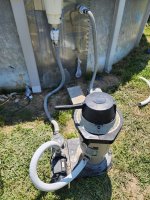
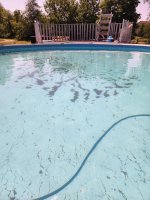
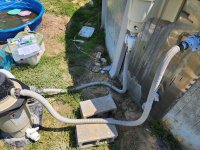
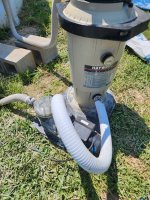
Thanks
Apparently I have too much time on my hands this year because I have decided to wage the ever-ending war against my insanely High total alkalinity. It's sitting somewhere between 220 and 250. I use the TF 100 test kit like everybody else and it's amazing. I just don't know, when it says turn red, is it talking about when it just starts to turn a little pink.. a little bit more pink.. magenta.. fire engine red? That's not my main question that's a sidebar.
The pool math app does not tell you how much muriatic acid to add when you click on the results from your total alkalinity test. It just says use acid to bring it down and aerate to bring the pH back up. A general Google search tells me that in a 10,000 gallon pool I need approximately 25.6 oz of MA to lower my total alkalinity 10 parts per million. With trying to get my total alkalinity down to 90 that is a staggering 11 times 25.6 ounces. We're talking a coupe GALLONS of MA.
That said, I do have that much muriatic acid here. There's just red flags and alarm Bells whistles and alerts going off in my head about dumping 2 gallons of muriatic acid into this pool right now. I can't imagine how much it'll bottom out the ph. On a good note, the pool is not swimmable at this point. We just opened 3 days ago. I'm dealing with a bit of an algae bloom issue and I am getting it under control but my chlorine levels are north of 10 while my big ole DE filter (Hayward Ec40Ac, takes 4lb of DE) and pump continue to slave away at clearing it out. It appears most of the algea is dead (I think) which is great, but I'm having to bump my DE filter every 4 hours or so plus backwash a couple times in just a few days and deep clean the fingers out. Chlorine is too high to run the robot cleaner. I'm winning the battle on that front but I'm just a little confused on the total alkalinity.
Regarding my filter War here's how this is playing out. This filter is starting out at around 8:00 psi. That was as of 2:30 this morning. By 8:30 this morning that sucker went up 10 psi. This is after I completely deep cleaned all of the fingers last night. I mean this thing was squeaky clean. I was shocked. I can't understand how this pool filter is getting up in PSI so darn fast. I've been running this thing hard for 3 days so this LG really is under pretty good control at this point. The water is clearing up a lot and most of the stuff is just dead on the bottom. My chlorine levels dropped six part per million, though, from yesterday morning to this morning so maybe that's indicative of still some live algae? Keep in mind this pool is sitting in Broad sunlight every hour of the day and we're hitting 90° here in Southwest Ohio which is unusual for this time of year.
As usual I'm checking the pump religiously and bumping it as needed. It hqw gone up 1psi from 10:20am to 11:50 today so 1.5 hours. This morning it went up 2 psi in 2:10.
I can't figure out if there's another issue here other than the filter just getting full. I mean there's 4lb of DE in there... That gas been back washed twice and the filter deep cleaned once




Thanks
Last edited:



